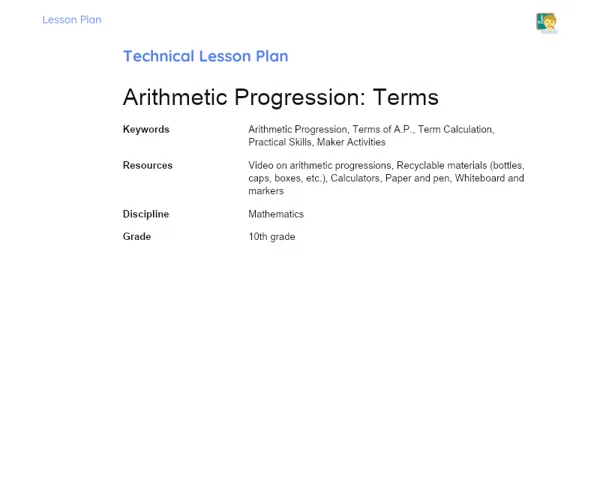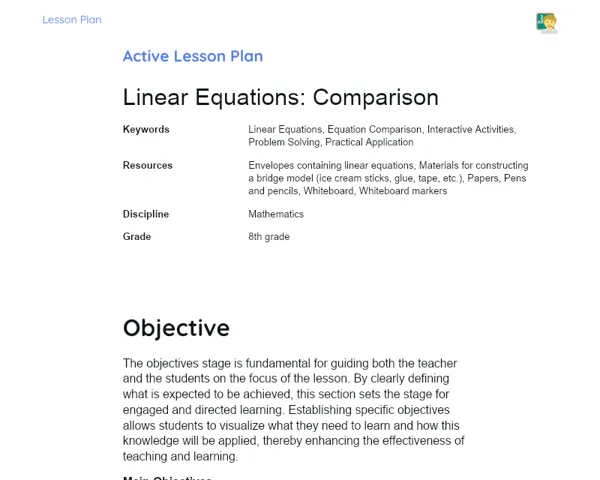Lesson Plan | Lesson Plan Tradisional | Radication: Properties
| Keywords | Radicals, Properties of roots, Square roots, Cube roots, Simplification of expressions, Operations with roots, Problem solving, High school mathematics, Practical applications, Real-world problems |
| Resources | Whiteboard, Markers, Eraser, Projector, Presentation slides, Scientific calculators, Notebooks and pens for note-taking, Printed exercise handouts |
Objectives
Duration: 10 - 15 minutes
This phase aims to provide students with clear and specific objectives for the lesson on radicals. By outlining the skills to be acquired, students can appreciate the relevance of the subject matter and focus on the competencies they need to develop. This clarity at the outset is essential for steering the learning journey and ensuring all learners are on the same page regarding class expectations.
Objectives Utama:
1. Identify the properties of radical expressions.
2. Apply the properties of radical expressions to solve problems involving square roots, cube roots, and more.
3. Tackle problems that incorporate the properties of radical expressions.
Introduction
Duration: 10 - 15 minutes
This phase aims to contextualize the lesson's topic, igniting students' curiosity and showcasing the practical importance of radicals. By forging a connection between theoretical principles and real-life applications, learning becomes more relevant and engaging, laying a solid groundwork for the deeper exploration that will follow.
Did you know?
Did you know that radicals play a role in analyzing financial data? For instance, while calculating the annualized growth rates of investments, we employ roots to compute the geometric mean of these growth rates. This understanding is essential for investors keen on evaluating their financial performance over time.
Contextualization
To kick off the lesson on radicals, emphasize that mathematics serves as a crucial tool for tackling complex issues. Radicals form a core part of mathematical operations, appearing in many everyday scenarios, including physics, engineering, and even economics. A straightforward example is when calculating the area or volume of geometric shapes, where square and cube roots help determine size and capacity. Furthermore, mastering radical expressions is vital for comprehending more advanced math concepts encountered later on.
Concepts
Duration: 40 - 45 minutes
This phase aims to deepen students' comprehension of radical properties, establishing a robust foundation for solving mathematical problems. By discussing each topic with clear illustrations, teachers help students grasp and apply the properties of radicals across various scenarios. Classroom exercises allow students to practice and reinforce their understanding, pinpointing and addressing potential challenges.
Relevant Topics
1. Definition of Radicals: Clarify the concept of radicals as the mathematical operation that reverses exponentiation. Explain that radicals entail finding a number that, when raised to a certain power, returns a specific number. For example, the square root of 25 is 5, as 5 squared equals 25.
2. Properties of Roots: Highlight the primary properties of radicals, including the product property (√a * √b = √(a*b)), the quotient property (√(a/b) = √a / √b), and the property relating to the root of a power (√(a^n) = a^(n/2)). Provide simple examples to exemplify each of these properties.
3. Square and Cube Roots: Differentiate between square and cube roots, clarifying that the square root of a number is one that gives the original number when squared, whereas the cube root is one that returns the original number when cubed. Use numerical illustrations for better understanding.
4. Simplification of Expressions with Roots: Demonstrate how to simplify expressions that contain roots. Walk through the step-by-step method involving factoring numbers inside roots and applying the properties of radicals to achieve the final simplified expression.
5. Operations with Roots: Discuss how to perform addition, subtraction, multiplication, and division with roots, using real-world examples to illustrate each operation.
6. Solving Practical Problems: Present real-world problems that require applying the properties of radicals, such as calculating areas and volumes or addressing financial scenarios.
To Reinforce Learning
1. Simplify the expression √50 * √2.
2. Calculate the cube root of 27 and explain how you arrived at the answer.
3. Solve the expression √(16/4) using the properties of radicals.
Feedback
Duration: 20 - 25 minutes
This phase is designed to solidify students’ learning by clarifying any uncertainties and reinforcing concepts previously introduced. Discussion of resolved queries allows educators to gauge student understanding and rectify any misconceptions. Engaging students through reflective questioning fosters active participation and the exchange of ideas, enriching the learning experience.
Diskusi Concepts
1. Question 1: Simplify the expression √50 * √2. 2. Explain that, according to the product property of roots, we can multiply the values inside the roots and then take the square root of the resultant value. Therefore, √50 * √2 = √(50 * 2) = √100 = 10. 3. Question 2: Calculate the cube root of 27 and explain the process. 4. Clarify that the cube root of a number is the value that when multiplied by itself thrice gives the original number. As 3 * 3 * 3 = 27, it follows that the cube root of 27 is 3. 5. Question 3: Solve the expression √(16/4) using the properties of radicals. 6. Using the quotient property, we can split the root of the numerator and the denominator. Thus, √(16/4) = √16 / √4 = 4 / 2 = 2.
Engaging Students
1. Pose the question to the students: Why is understanding radical properties essential when simplifying mathematical expressions? 2. Encourage students to share examples from daily life where radicals find application. 3. Inquire: What challenges did they face while solving the expressions? How did they manage to overcome those hurdles? 4. Promote small group discussions among students about applying radical properties to previously presented practical problems. 5. Request students to express, in their own words, how radical properties aid in resolving complex expressions.
Conclusion
Duration: 15 - 20 minutes
The aim of this stage is to reinforce the critical points covered during the lesson, solidifying students’ understanding. Recapping content helps students consolidate what they learned, while connecting to practice and highlighting the importance of the topic motivates and adds value to the knowledge gained. This stage also creates an opportunity to clarify any remaining questions.
Summary
['Defining radicals as the inverse operation of exponentiation.', 'Highlighting the core properties of radicals: product of roots, quotient of roots, and root of a power.', 'Clarifying the distinction between square and cube roots.', 'Demonstrating simplification of expressions that incorporate roots.', 'Covering operations with roots: addition, subtraction, multiplication, and division.', 'Addressing practical problem-solving using radical properties.']
Connection
The lesson bridged the theory of radicals with practical applications, using clear examples and demonstrating how radical properties can be applied to solve real-world problems. Through practice exercises and discussions, students recognized the relevance of radicals in various fields, including area and volume calculations and financial analysis.
Theme Relevance
Grasping radical properties is vital for solving intricate mathematical problems and has broad applications in everyday life. For instance, in fields like engineering, physics, and economics, radicals come in handy for calculating dimensions, capacities, and analyzing financial data. A solid understanding of these properties enhances one's ability to interpret and tackle problems involving roots, rendering learning more significant.



